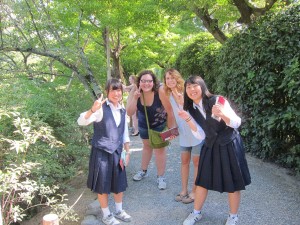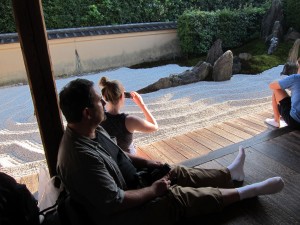Our day began early again, at 5:30 am for those who walked up to Chion-in for the morning services. We packed up, put our luggage on the bus and headed to Ryoan-ji, perhaps the most iconic of the karesansui, the dry Japanese Zen gardens.
These dry gardens were often constructed for night meditations in front of the abbot’s quarters, the purpose of the white stones is to reflect moonlight. The garden at Ryoan-ji in the bright sunshine and heat of a Kyoto autumn day is a bit of a different space than at night, I suspect. And the rich mix of tourists, from Japanese school children here on field trips to couples with tour guides, and us, makes it far less still and silent than it would be “in use.”
The school children on field trips to these places have assignments from their English teachers to practice their English, generally with some prompts for questions to ask: Where are you from? Why are you here? What is most important to you? Our students enjoyed practicing their Japanese in return. They got more practice in reading Japanese as they tried to negotiate the vending machines to find something cool to drink.
Daitoko-ji is a complex of Rinzai Zen monasteries on the edge of Kyoto. We visited two of the cloisters within the monastery: Daisen-in and Zuiho-in. Both have beautiful dry gardens, though on some level these are less abstract than the one at Ryoan-ji. You aren’t allowed to photograph the gardens at Daisen-in, so I had to stick to postcards. The garden wraps around the dojo, a stream that eventually opens into a garden that is just groomed white rocks, with two cones, the better to reflect the moonlight in the garden.
From there we went to Zuiho-in, which has to my mind the most beautiful of all the dry gardens I have seen. The large garden is meant to represent a heavy sea with the sand all piled up to represent high waves. It’s focussing on one level, despite the clear chaos you can sense underlying the stillness. It reminds me of Marty Laird’s comment in Into the Silent Land that contemplation isn’t “snorting lines of euphoric peace” but a particular way of sitting with chaos.




